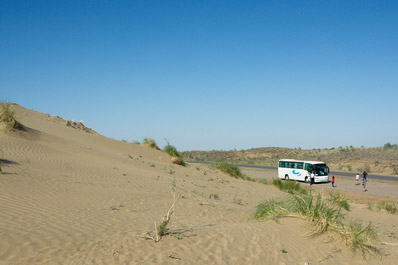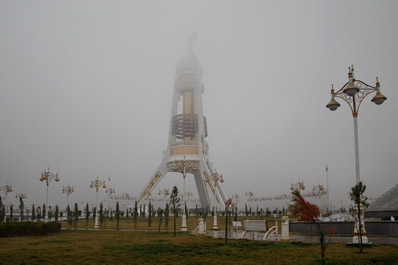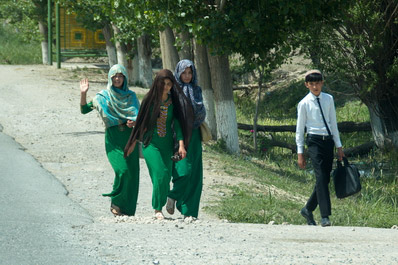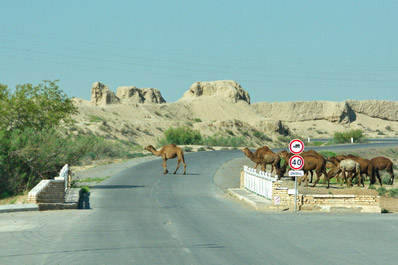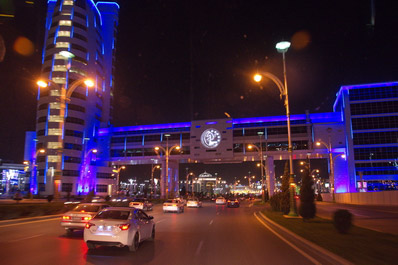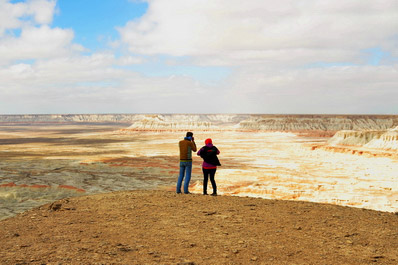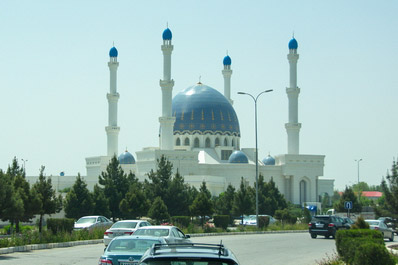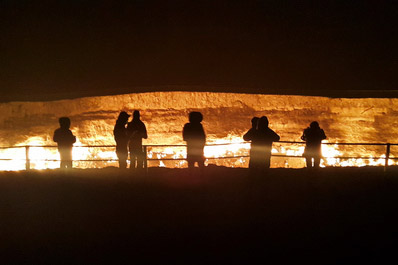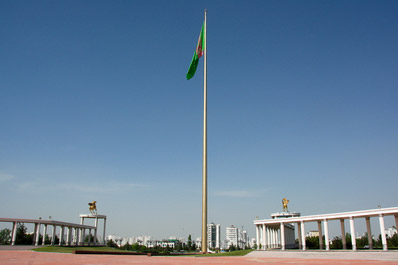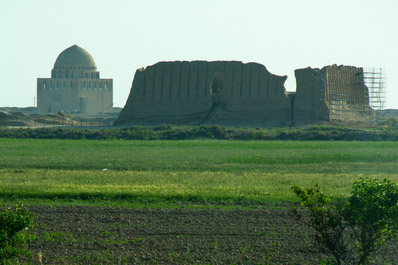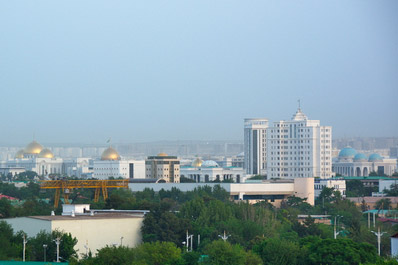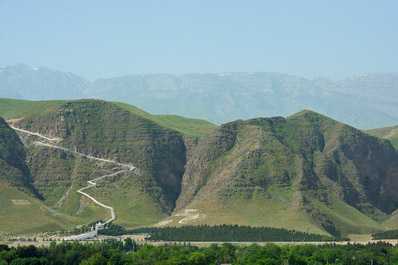Turkmenistan Travel Guide
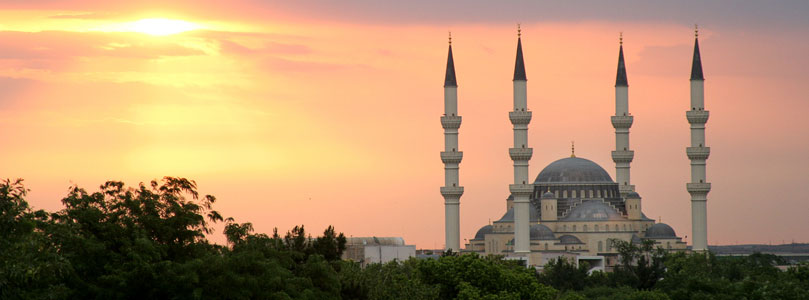
Turkmenistan is located at the very heart of Central Asia, and its position at the crossroads of Asia is apparent – the language and alphabet resemble Turkish, the cuisine is heavily influenced by Iran, the fierce independence of the Turkish people reflective of tribal Afghanistan and the religious practices similar to other post-Soviet Central Asian nations.
Yet despite countless influences from ancient invaders and present-day neighbors, the Turkmen people have retained an identity uniquely their own. Of all the Central Asian nations, Turkmenistan alone is home to the awe-inspiring cliffs of Yangykala Canyon, the futuristic white-marbled capital Ashgabat, an underground sulfuric lake where visitors can go for a therapeutic swim and the incessantly burning Darvaza Gas Crater better known as the ‘Gates of Hell’.
Granted, Turkmenistan visas can be a challenge to procure and the conditions in country may present certain challenges, but tourists who choose to visit Turkmenistan almost exclusively speak of it as a thrilling, unforgettable experience that they would gladly choose again.
Our Turkmenistan Travel Guide aims to answer travelers’ most frequent questions about this secretive country and prepare you for your upcoming trip!
General information about Turkmenistan:
Turkmenistan Capital: Ashgabat
Population: 5.94 million (2019)
Languages: Turkmen, Russian
Religion: Islam (89%), Eastern Orthodox (9%), other (2%)
Electricity: 220V AC, 50 Hz; Round two-pin continental plugs are standard
Time zone: GMT+5
International dialing code: +993
Monetary unit: Turkmenistan manat
When is the best time to visit Turkmenistan?
Turkmenistan is a desert country, with many of its finest attractions square in the middle of the wilderness, and this should be kept in mind when planning your trip. The country is at its best in spring, from mid-March to May, or from late September through November. Winters can be frigid in the north and in the desert, but milder in the south. Summertime, especially July and August, is scorching hot, with temperatures easily soaring above 50 Celsius.
For travelers interested in participating in a local holiday, Navruz (Persian New Year) can be a great option. It falls on 21-22 March, just as the first blossoms are appearing on the trees and the weather begins to warm up for spring. It’s also one of the most colorful and festive celebrations in the country, and a great way to participate in local customs.
Bear in mind that during certain national holidays, particularly Independence Day on September 27, city streets and tourist attractions may be closed, and border crossings may not be functioning for several days before and after the holiday.
What airlines fly into Turkmenistan?
Turkmenistan is surprisingly easy to reach by air via major hubs in Central Asia, Turkey, the Caucasus, Dubai, Russia, Europe, India, Thailand and China.
The following airlines service flights to Turkmenistan, and further information can be found on their websites:
Belavia
China Southern Airlines
FlyDubai
Lufthansa
S7 Airlines
Turkmenistan Airlines*
Turkish Airlines
*Turkmenistan Airlines is by far the most common carrier, and currently it’s only possible to purchase tickets with them through a qualified travel agency. Contact us to get an up-to-date travel timetable or purchase tickets.
Can you travel to Turkmenistan by land?
It’s possible to enter Turkmenistan by land via its borders with Iran, Kazakhstan, Uzbekistan and Afghanistan. As there are no train or bus services to Turkmenistan, land crossings must be done by private car or on foot. Each land crossing is located in a relatively isolated area, so if you don’t have your own vehicle, be prepared to hire a taxi to the Turkmenistan border and to walk a kilometer (or five) in between checkpoints. The Kazakhstan and Afghanistan crossings tend to be the most rugged.
Most borders are open from around 9am-6pm and close for a one-hour lunch break at 1pm, but times vary at each crossing, and thus it’s advised to allow yourself plenty of time to cross before the evening closure.
Expect more thorough luggage searches at land crossings than at the airport, and when possible keep an eye on your valuables while they’re being searched. Any vehicle brought into the country is subject to fees from $100-150.
If arriving from Azerbaijan, entering Turkmenistan by ferry is also possible. There is no set timetable for ferry departures, but Azerbaijan-owned cargo ferries make the Turkmenbashi-Baku route 3-4 times per week. Passengers and private vehicles are also allowed on these boats for a fee, and the ferry has several basic sleeper cabins that are rented out to passengers.
The ferry crossing takes anywhere from 12-24 hours, in addition for time to embark and disembark the boat. As there is no restaurant on board, passengers are strongly encouraged to bring their own stock of food and drink supplies. The ferry can be a fun and unique experience, but keep in mind that departure times are quite unpredictable and dependent on weather and cargo needs. When the vessel is transporting crude oil, passengers are not allowed on board.
Do I need a visa for Turkmenistan?
Citizens of all nations are required to have a visa to enter Turkmenistan, and while obtaining a visa isn’t simple, it is possible!
Two types of visas are available to tourists, a transit visa and a tourist visa. The good news with a transit visa is that you’re not required to be accompanied by a guide while traveling, and a Letter of Invitation (LOI) from a travel agency is rarely required. The downside is that you must be traveling from one adjoining country to the next, with visas from those countries proving your route, in order for your request to be accepted. Transit visas also tend to be rejected more frequently than LOI-supported tourist visas, particularly if you apply around a Turkmenistan national holiday. When issued, they’re given for 3-7 day periods.
The second option is to apply for a tourist visa, which is possible only with a visa support letter (LOI) from a recognized travel agency. Visa costs range from $60-$100. Citizens of Russia, Ukraine and other Central Asian nations are nearly always rejected for a tourist visa. More recently Chinese nationals have been rejected at abnormal rates, while citizens of other nations seem to have a better chance of approval.
Check out the Turkmenistan Visa Page for more detailed information.
A tourist visa to Turkmenistan is usually granted for the duration of your pre-arranged tour in Turkmenistan. Visas can be issued upon arrival at the airport or land border, provided you’ve already been approved and have the LOI on hand. If entering the country on a tourist visa, you are required to have a tour guide with you at nearly all times.
What are the customs regulations of Turkmenistan?
When entering Turkmenistan, you’ll be required to fill out a customs declaration form and will be given a travel pass, both of which you must save and present again upon your departure. All hotel stays will be recorded on this travel pass by the hotel staff. You’ll also need to pay an arrival tax of approximately $14 (travelers on a transit visa are exempt from this) and if receiving your visa on arrival, this will cost an additional $100.
You will need to present a doctor’s prescription at the border for any prescription medications you plan to bring into the country, and any non-prescription medications are officially required to be declared on the customs form. Certain medications such as codeine, Tramadol, anti-depressants or sleeping pills may present a problem at the Turkmenistan border regardless of whether or not you have a prescription. If you want to avoid the possibility of confiscation or hassle, it’s recommended to leave them behind if possible.
Do I need to register in Turkmenistan? How do I register?
Tourists passing through on a transit visa are not required to register unless you’re on a 7-day visa, in which case you’ll need to pay a visit to the Department of Tourism and Sports to register yourself (but registration is a small price to pay in exchange for being granted the rarely seen 7-day transit visa!)
Travelers on a tourist visa are required to register within three working days after arrival (excluding the day of entry). This service is nearly always provided by your supporting travel agency as a part of the tourism package but double-check with them in advance just to be certain.
What do they speak in Turkmenistan?
Turkmen is the official language of Turkmenistan; it’s used in all government matters and is the primary language of communication in everyday life. Turkmen is a Turkic language, most closely related to Turkish and Azerbaijani and written in a modified Latin script such as is used in Turkey.
Russian is spoken as a second language by some people in the cities, and English by even fewer. Uzbek is widely spoken in the northern territories near the Uzbekistan border, and minority languages such as Balochi can be heard in select communities.
Is English spoken in Turkmenistan?
Since Turkmenistan has remained much more isolated from the world than its neighbors, English and even Russian are spoken less here than in Kazakhstan, Uzbekistan or the Caucasus.
Unless you speak Turkmen, you may be hard-pressed to find a common language with many people, particularly in your rural travels. Thankfully, as travelers on a tourist visa must be accompanied by a tour guide at all times, this shouldn’t be a matter for concern. If you manage to have some alone time for exploration in the cities or are passing through on a transit visa, though, the language barrier can heighten the sense of adventure and reveal just how patient and helpful many Turkmen are to travelers in need.
Is Turkmenistan safe for tourists?
Due to its isolation and governing bodies, Turkmenistan is often seen in a negative light. In reality, though, it is a very safe country to visit. Violent crime is very rare, and even petty theft and pickpocketing are uncommon.
As with any place you travel, we recommend that you keep your passport and valuables in a safe place and be particularly cautious in crowded areas, such as bazaars, trains and the Caspian Sea resort town. On the flip side, be cautious in extremely rural areas, where you could become an easy target if traveling alone. Avoid using gypsy cabs.
Be mindful of the laws regarding restricted areas near border zones, for which a permit obtained in advance will be required for entrance. Photography is prohibited in certain places and Ashgabat maintains a strict 11pm curfew. Speak respectfully of the Turkmenistan president and of the land in which you are a guest.
Health care in Turkmenistan is well below international standards, and it’s recommended to be up to date on all vaccinations, particularly Hepatitis A and typhoid, and to bring an adequate supply of medications with you. See “What are the Customs Regulations of Turkmenistan?” below for further info on bringing medications through customs.
Is Turkmenistan safe to travel alone?
Turkmenistan is generally a very safe country, and solo travelers should have little to worry about. Bear in mind, however, that unless you have a transit visa, you are legally required to have a guide with you at all times when traveling between cities, and cannot obtain a tourist visa unless you have pre-purchased a tour package with a licensed travel agency. Thus, traveling alone in Turkmenistan can quickly become expensive (and you won’t really be alone, as your guide will be by your side nearly the whole time).
In addition, you will not find hostels or other budget accommodation that are usually ideal spots for meeting up with other solo travelers but will be required to stay in officially recognized hotels. If you’re traveling alone, joining a group tour to Turkmenistan can be a great option.
Female travelers are advised not to walk alone in Ashgabat, Turkmenistan after dark, as this is countercultural to local custom and could invite problems. Since there is an 11pm curfew strictly enforced for everyone in the capital, you won’t be missing out on much.
Is Turkmenistan expensive?
Visiting Turkmenistan can be challenging for the budget traveler. It’s the most expensive country in Central Asia, and in 2019 Ashgabat was ranked as the most expensive city in the world for expatriates to live. This is due in part to the country’s rich oil reserves, but also to its general reclusiveness and the recent economic crisis that has led to severe inflation and exorbitant prices on imported goods.
If you’re passing through Turkmenistan on a transit visa, you’ll have more flexibility to pull off a Turkmenistan budget tour by choosing cheaper meals and hotels. For anyone on a tourist visa, you’ll be required to stay in more upscale accommodation and pay for your guide’s meals, transportation and lodging for most of the trip.
Be advised that Turkmenistan is a cash-based economy with very few functioning ATMs. It’s advised that you carry in all the cash that you intend to spend in country.
What do they eat in Turkmenistan?
Turkmenistan's cuisine is very similar to that of other Central Asian countries, but with a stronger Iranian influence. Many dishes are meat heavy, particularly with mutton, although beef, poultry and lamb are also widely eaten. In keeping with Islamic tradition pork is prohibited, but unlike its neighboring countries, horses are held in high esteem and thus horse meat is illegal. Other common ingredients include rice, vegetables, onions and herbs.
Meals often begin with soup. Chorba, a meat and vegetable soup, is very popular, as is dogroma chorba, comprised of meat, innards, bread and onions.
Plov (pilaf) - a one-dish meal served with mutton, onions, carrots, spices, raisins or chickpeas.
Manty - steamed dumplings stuffed with lamb or beef and onion.
Ku'urma - lamb cooked in its own fat
Govurma - fried meat and onions served either hot or cold
Ichlekli - meat and onion pies.
Shashlyk – kebabs of stewed, boiled or roasted meats. Goat kebab and Steppe Shashlyk are considered Turkmen specialties.
Gutap - small pie filled with meat, potatoes, spinach or pumpkin.
Dograma – tender meat and chunks of bread mixed together and served with onion and broth.
Green tea and bread are essential at every meal. Turkmen people like to drink gok chai, green tea with dried fruit, mint or other herbs.
Despite the Turkmen people’s love of meat, vegetarians can find a variety of healthy options throughout the country. Bazaar and markets will be overflowing with fresh fruits, vegetables and herbs from late spring to early autumn, and even in the off-season basic produce and nuts can be found. In cafes, salads and side dishes of rice or potatoes are a good option. For hot meals, consider pumpkin manty, potato pastries (samsas) or a spinach or potato gutap. A variety of fresh and delicious milk products can also be found. In Ashgabat there’s a decent selection of international cafes and pizzerias with vegetarian choices.
Can you drink alcohol in Turkmenistan?
Alcohol can be purchased and consumed in Turkmenistan, but if heavy drinking is your idea of a good vacation, Turkmenistan is probably not the country you’ll want to visit. The consumption of alcohol is forbidden in certain areas, including parks, trains, train stations, airports, government offices, boats, ferries, and most public spaces. However, alcohol may be purchased and consumed in bars and some restaurants.
What should I wear in Turkmenistan?
Turkmenistan has no official dress code, and while many Turkmen wear traditional clothing, European dress is acceptable. Tourists wishing to show the greatest respect for local customs, however, should keep the conservative culture in mind: local women generally wear their hair pulled back and wear long, loose-fitting dresses with their shoulders covered, while men wear slacks with a short or long-sleeved shirt and sometimes a traditional cap. Local Turkmen style is usually more formal than typical Western attire.
When visiting religious sites, shorts and sleeveless shirts are not acceptable for either gender, and women may be asked to loosely cover their heads.
Summer travelers will want to dress to stay cool and protect themselves from the sun. Bring a hat or head covering, light-colored cotton clothing, and plenty of sunscreen. Sandals will be most comfortable in the cities, while close-toed shoes are recommended for rural and desert areas. If traveling in the cooler months, layered clothing is a good idea, with appropriate winter attire for mountain trips and chilly desert nights.
What accommodations are available in Turkmenistan?
If traveling on a tourist visa in Turkmenistan, you’ll be required to stay in upscale government-approved hotels in every city you visit. Most of these hotels are 3 to 5-star accommodations that are clean and comfortable with a range of amenities and filling breakfasts.
If on a transit visa you’ll have a bit more flexibility, albeit a limited number of budget options which, as of 2019, can only be booked in advance through select travel agencies. The widest selection of options is in Ashgabat, but once outside of the capital, options are limited and often of poor quality.
How do you get around Turkmenistan?
If you’re traveling on a tourist visa, your guide is required to accompany you at all times outside of the major cities, so you will likely be doing most of your travels via private car, van or 4WD. While it may be less adventuresome, this requirement will save you the hassle of trying to negotiate your way with shared taxis and ticket agents, and is the quickest, most comfortable way of travel.
If passing through on a transit visa, you’ll need to pay a tax based upon the route that you take through the country, but you’ll be free to travel provided you stay on your approximate approved route.
Other options for the independent traveler:
Turkmenistan has a well-developed train system within the country, and a train ride can be a great way to meet locals and experience everyday Turkmen culture. While the daytime train provides you with more opportunities for social interaction and enjoying the passing scenery, the night train can save you the expense of a night in a hotel and can help the long traveling hours to pass more quickly.
Airline travel within Turkmenistan is by far the fastest option for intercity travel, with Turkmenistan Airlines servicing all the major cities with regular flights and reasonable pricing. These tickets cannot currently be purchased online, so you’ll need to obtain them in country or book them in advance through a certified travel agency, including OrexCA.
If you’re looking for the cheapest, slowest and most uncomfortable option, a long ride on a bus or marshrutka (public van), is the way to go.
Shared taxis can be a great option for travel between cities; you’ll pay a bit more than you would for a bus or marshrutka ride but will save time and have a more comfortable ride. The taxi leaves once it’s full, and the excitement of taking a cross-country drive with strangers is an added bonus.
What is Turkmenistan famous for, and what kind of souvenirs can I bring home?
Turkmenistan rightly takes pride in its Akhal-Teke horses, known for their lightning speed, agility, gracefulness and beauty. Turkmen carpets, diverse in color and design and hand-woven of silk, cotton or wool, are some of the most expensive and sought-after carpets in the world. The country is also well-known for its scrumptious melons, Ashgabat’s white-marbled buildings, the Darvaza Gas Crater and rolling sands of the Karakum Desert.
Unfortunately, most of these items cannot be packaged up and taken home with you, save the carpets, which cost hundreds or thousands of dollars. Truth be told, Turkmenistan does not have the diverse and affordable selection of souvenirs found in its neighboring countries. This is due, in part, to the fact that very few tourists visit Turkmenistan compared to the other countries, so count souvenir hunting as part of the adventure of traveling in such a mysterious land.
Affordable souvenirs that can be found in the larger cities and bazaars include Turkmen skullcaps, headdresses, ceramic whistles (djul-djul), local jewelry, Akhal-Teke horse statuettes and national telpak hats, made of sheep wool and guaranteed to keep you warm in winter.
Can I use credit cards in Turkmenistan?
The use of credit cards is very limited in Turkmenistan, so unless you’re at a 5-star hotel or restaurant, be prepared to pay for everything in cash. ATMs are limited to large cities, and only a select few in Ashgabat will accept foreign debit and credit cards. To withdraw money on your Visa or Mastercard, your best bet is to visit the modern Berkarar Mall or major hotels such as the Ak Altyn, Nissa or Grand Turkmen.
It’s highly recommended to bring all of the cash that you’ll need with you into the country. US dollars are the most widely accepted, and if these are not new, crisp, unmarked bills, there’s a chance that they could be rejected or exchanged at a lesser rate. USD can be exchanged for Turkmen manat in most large hotels, banks, airports and railway stations. Bear in mind that manat cannot be exchanged back to USD in Turkmenistan, and once you’ve left the country you will not be able to exchange manat anywhere.
There is currently an economic crisis that has led to a shortage of manat in country, with local residents waiting in long lines to receive their money from banks or ATMs. This issue should not directly impact tourists, but it’s good to be mindful of the situation.
Does Turkmenistan have internet?
It’s possible to buy a local SIM card from TM Cell, currently the only mobile provider in Turkmenistan. SIM cards may be purchased at the airport upon arrival, at the Russian Bazaar or at a TM Cell store for about $30. If they agree to sell you a card as a foreigner, you’ll be required to show them your passport and visa. Coverage is generally good in the cities but much less reliable in rural areas.
Wifi is slowly becoming more available, but free wifi is rare and your best bet for decent internet connection is still at the large hotels (specifically the Grand Turkmen) or at an internet café. Ashgabat is worth visiting not only for its white-marbled buildings, but for the most reliable internet in the country.
Most social networking and news sites are blocked, and even with many VPNs these are impossible to access.
What should I expect when exiting Turkmenistan?
Before leaving Turkmenistan, make sure you have all of your necessary documents handy:
- Passport
- Travel Pass, issued to you upon arrival
- Copy of the Customs Declaration Form issued to you upon arrival
- A valid visa, meaning that you are leaving on or before the final day of the visa
- Export license if you’ve purchased a carpet or other items of national value
When exiting Turkmenistan, you’ll need to fill out another customs declaration form stating that you are leaving the country with less money than when you entered, in addition to presenting the customs form that was filled out upon arrival. If you have purchased a carpet or other items of national value, be sure that you’ve received the necessary export license, which may be obtained directly from select carpet sellers or from the Carpet Museum in Ashgabat.
Note: The amount of currency that you carry out with you should not exceed the amount that you carried in. Upon entry and/or exit, you may be asked to count your money in front of them as proof.
If you’ve found this Turkmenistan Travel Guide helpful, check out our travel guides for other Central Asian and Caucasus nations to learn more about the region!

